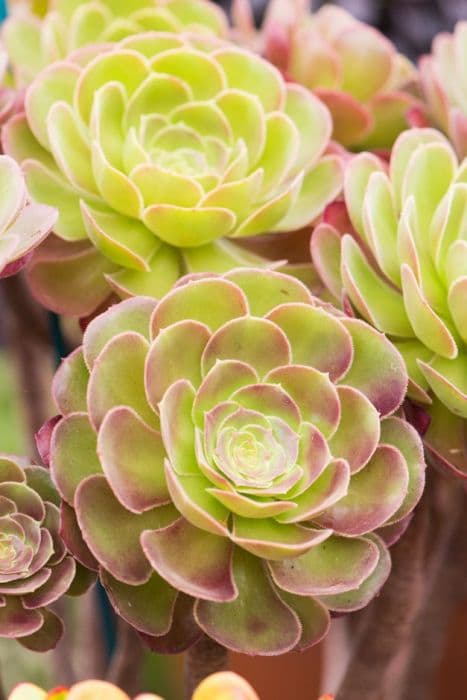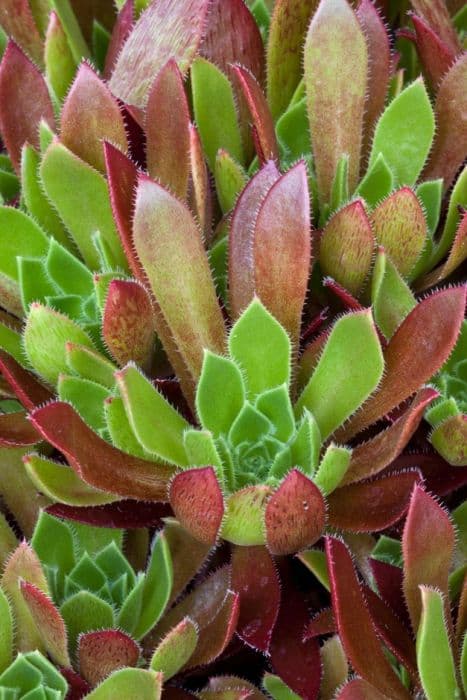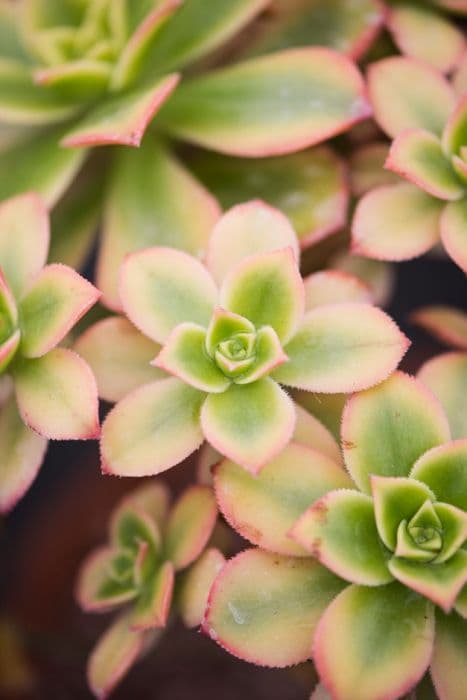Balsamiferous aeonium Aeonium balsamiferum

ABOUT
Aeonium balsamiferum, commonly known as Balsam Aeonium, is a succulent plant that boasts a stunning rosette shape, characteristic of the Aeonium genus. The Balsam Aeonium has fleshy, spoon-shaped leaves that are arranged in a circular pattern, spiraling outwards from the central point of the rosette. These leaves are glossy and can vary in color from bright green to a more glaucous tone, sometimes with a hint of red or purple at the margins, especially when exposed to sunlight. The texture of the Balsam Aeonium's leaves is smooth to the touch, with a plump and turgid quality that exemplifies its succulent nature. The plant has a branching habit, often forming clusters of rosettes that emerge at the ends of its stems. When in bloom, the Balsam Aeonium produces pyramid-shaped clusters of small, star-shaped flowers. These flowers are typically yellow, adding a contrasting spot of color against the greenery of the leaves. Though small in size, the Balsam Aeonium’s architectural form and the geometric precision of its rosettes make it an attractive addition to any succulent collection or as a stand-alone ornamental plant in a suitable climate. It is well-adapted to rocky, dry environments and thrives in areas with lots of sunlight. Its ability to store water within its leaves allows it to withstand periods of drought, common to its natural habitat.
About this plant
 Names
NamesFamily
Crassulaceae
Synonyms
Balsamiferous Aeonium
Common names
Aeonium balsamiferum
 Toxicity
ToxicityTo humans
Aeonium balsamiferum, commonly known as Balsamiferum, is not widely recognized as a toxic plant to humans. However, as with many plants, individuals may have varying levels of sensitivity, and ingestion is not recommended. If a person has a particular sensitivity or allergy to the plant, they may experience gastrointestinal upset such as nausea, vomiting, or diarrhea if they ingest parts of it. It is always advisable to keep plants out of the reach of children and to educate them not to consume any plant material.
To pets
Balsamiferum is not commonly listed as a toxic plant to pets either. Although it's unlikely to be harmful, pets vary in their sensitivity to plants, and some might experience mild digestive distress after ingesting it, such as vomiting or diarrhea. As a precaution, it is best to prevent pets from ingesting this plant. If you suspect your pet has ingested a potentially toxic plant, contact a veterinarian.
 Characteristics
CharacteristicsLife cycle
Perennials
Foliage type
Evergreen
Color of leaves
Green
Flower color
Yellow
Height
2 feet (61 cm)
Spread
2 feet (61 cm)
Plant type
Succulent
Hardiness zones
9
Native area
Canary Islands
Benefits
 General Benefits
General Benefits- Decorative Appeal: Adds aesthetic value to gardens and indoor spaces with its rosettes of succulent leaves and attractive growth patterns.
- Drought Tolerance: Highly adaptable to arid conditions, making it a sustainable choice for water-wise gardening.
- Low Maintenance: Requires minimal care once established, needing only occasional watering and infrequent fertilizing.
- Pest Resistant: Generally resistant to pests, reducing the need for chemical interventions.
- Soil Erosion Control: Can help prevent soil erosion in landscapes due to its root structure.
- Suitable for Containers: Well-suited for growing in pots, which makes it a versatile option for balconies and small spaces.
- Attracts Pollinators: Flowers may attract bees and other pollinators, supporting local ecosystems.
- Easy Propagation: Easily propagated from cuttings, which allows for quick and inexpensive expansion of your garden.
- Long-lived: With proper care, it can live for many years, providing long-term enjoyment.
- Heat Tolerance: Can survive in high temperatures, which is beneficial in warm climates.
 Medical Properties
Medical PropertiesThis plant is not used for medical purposes.
 Air-purifying Qualities
Air-purifying QualitiesThis plant is not specifically known for air purifying qualities.
 Other Uses
Other Uses- Aeonium balsamiferum, commonly known as balsamiferous aeonium, can be used as a natural insect repellent due to its aromatic sap which deters certain insects.
- The sap of the balsamiferous aeonium may be used in traditional crafting to create a sticky substance for small-scale model making or as a natural glue in art projects.
- The fleshy leaves of the plant might be used by hobbyists in miniature garden landscapes to simulate larger tree forms due to their unique shape and structure.
- Cuttings of the balsamiferous aeonium can be used as an organic alternative to synthetic sponges for household cleaning tasks, as the leaves can be quite durable.
- The distinctive rosettes of the balsamiferous aeonium can serve educational purposes in botany classes, demonstrating succulent adaptation and structure.
- Photographers and filmmakers might use this plant as a prop or set decoration to evoke an exotic or otherworldly environment in visual storytelling.
- Enthusiasts of the balsamiferous aeonium might collect and display various cultivars as a hobby, similar to philately or numismatics.
- Balsamiferous aeonium can be used in the creation of sustainable, biodegradable floral arrangements that require minimal water and upkeep.
- Due to its attractive appearance and hardiness, this succulent may be used for green roofing projects, which helps to insulate buildings and increase biodiversity.
- Growers of balsamiferous aeonium could harvest seeds from the plant to trade with other enthusiasts, thus helping to preserve the diversity of the species.
Interesting Facts
 Feng Shui
Feng ShuiThe Aeonium is not used in Feng Shui practice.
 Zodiac Sign Compitability
Zodiac Sign CompitabilityThe Aeonium is not used in astrology practice.
 Plant Symbolism
Plant Symbolism- Resilience and Survival: Being a succulent, Aeonium balsamiferum often symbolizes the ability to persevere and thrive in harsh conditions, as succulents retain water and are typically very hardy.
- Timelessness: The evergreen nature of this plant, with its perennial life cycle, represents enduring and lasting qualities.
- Uniqueness: With its distinctive rosettes of leaves and occasional blossoms, Aeonium balsamiferum can symbolize uniqueness or standing out from the crowd.
 Water
WaterThe Aeonium, commonly known as balsamiferum, prefers a thorough watering when the soil is completely dry which typically means watering it approximately every 7 to 10 days during active growth periods, and less frequently during its dormant phase in the hotter months. When you water, aim to use enough water so that it runs out the bottom of the pot, indicating that the soil is fully saturated. Depending on the size of your container, this might mean using around one-half to one gallon of water. Always check the dryness of the soil before watering to avoid overwatering, which can lead to root rot.
 Light
LightBalsamiferum thrives best in bright, indirect light but can also tolerate partial direct sunlight, especially in the morning. Placing it near a south or west-facing window with some form of light filtering, such as sheer curtains, would be ideal. Avoid exposing it to the harsh afternoon sun, which can scorch the leaves.
 Temperature
TemperatureBalsamiferum can survive in temperatures ranging from about 40°F to 100°F, but the ideal temperature for this succulent lies between 65°F and 80°F. It's important to protect it from frost as it is not tolerant of extreme cold.
 Pruning
PruningPrune your balsamiferum to remove any dead or damaged leaves and to maintain the desired shape. This is usually done in the spring before the new growth starts. Pruning can be done every few years, or as needed, to also help encourage bushier growth.
 Cleaning
CleaningAs needed
 Soil
SoilAeoniums need well-draining soil with added perlite or coarse sand to prevent water retention; a cactus or succulent mix works well. The ideal pH for Aeonium arboreum, commonly known as Tree Aeonium, is around 6.0 - 7.0.
 Repotting
RepottingTree Aeonium should be repotted every two to three years to refresh the soil and provide room for growth; repotting also helps to prevent soil compaction and nutritional depletion.
 Humidity & Misting
Humidity & MistingTree Aeonium prefers a dry climate and is tolerant of low humidity levels; avoid high humidity environments to decrease the risk of rot and fungal diseases.
 Suitable locations
Suitable locationsIndoor
Place Tree Aeonium in bright light indoors.
Outdoor
In bright, filtered light, protect from harsh sun.
Hardiness zone
9-11 USDA
 Life cycle
Life cycleAeonioum Balsamiferum, commonly known as Balsam Aeonium, begins its life cycle as a seed that germinates in well-drained soil with moderate moisture and ample sunlight. The seeds sprout into seedlings, which then develop into rosettes of succulent leaves as they mature. The rosettes grow slowly but steadily, producing offsets that can lead to clonal colonies over time. After a few years, the adult plant reaches maturity and sends up a flowering stalk during the spring or summer, boasting small, star-shaped yellow flowers. Following pollination, the flowers produce seeds before the flowering stem eventually dies. The parent plant, being monocarpic, may die after flowering, but the life cycle can continue through offsets and seeds that give rise to new plants.
 Propogation
PropogationPropogation time
Spring-Early Summer
Aeonium balsamiferum, commonly known as balsamiferous aeonium, is typically propagated through cuttings. The optimal time for propagation of this succulent is during its active growth period, which is generally in the spring or early summer. To propagate by cuttings, one would first need to select a healthy leaf or stem. A clean cut should be made, and it's important to let the cutting dry and callous over for a few days to avoid rotting when planted. After the calloused cutting has had a chance to dry, it is planted in well-draining soil, watered lightly, and provided with bright, indirect sunlight. Rooting usually occurs within a few weeks, after which the new balsamiferous aeonium can gradually acclimate to more direct sunlight.









